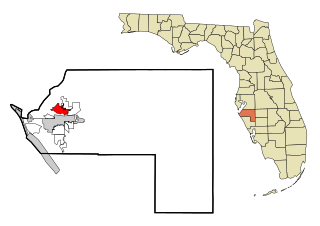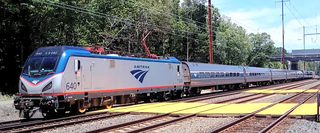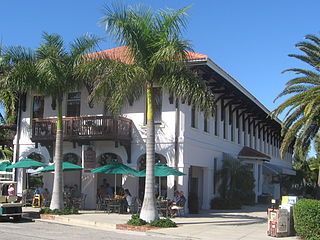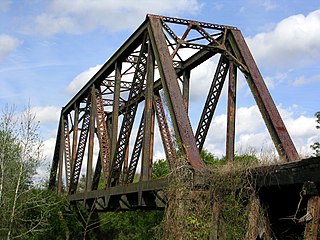
Palmetto is a city in Manatee County, Florida, United States. As of the 2010 census, the population was listed as 12,606. It is part of the North Port–Sarasota–Bradenton Metropolitan Statistical Area.
The Florida Northern Railroad Company, Inc. is one of several short line railroads run by Regional Rail, LLC. It has connections to CSX at Ocala, Florida, running north to Lowell, Florida, and south to Candler, Florida. It was formerly run by CSX as their Ocala Subdivision.

The Seminole Gulf Railway is a short line freight and passenger excursion railroad headquartered in Fort Myers, Florida, that operates two former CSX Transportation railroad lines in Southwest Florida. The company's Fort Myers Division, which was previously the southernmost segment of CSX's Fort Myers Subdivision, runs from Arcadia south to North Naples via Punta Gorda, Fort Myers, Estero, and Bonita Springs. The company's other line, the Sarasota Division, runs from Oneco south through Sarasota. Seminole Gulf acquired the lines in November 1987 and operates its own equipment.

The Silver Star is a passenger train operated by Amtrak on a 1,522-mile (2,449 km) route between New York City and Miami via Washington, D.C., Richmond, Raleigh, Columbia, Savannah, Jacksonville, and Tampa. The Silver Star and its partner in the Silver Service brand, the Silver Meteor, are the descendants of numerous long-distance trains that operated between Florida and New York for most of the 20th century.

The Florida Railroad Museum is a railroad museum located in Parrish, Florida. The museum operates a heritage railroad and offers round-trip tourist excursions along six miles of the former Seaboard Air Line Sarasota Subdivision in Manatee County between Parrish and Willow.

The First Coast Railroad is a class III railroad operating in Florida and Georgia, owned by Genesee and Wyoming Inc. The name is derived from its area of operations around the First Coast of Florida.

The Charlotte Harbor and Northern Railway is a historic railroad line that at its greatest extent serviced Gasparilla Island in Charlotte Harbor and a major shipping port that once operated there. The railroad's principal purpose was to transport phosphate mined along the Peace River and in the Bone Valley region of Central Florida to the port to be shipped. It also brought passengers to the island community of Boca Grande on Gasparilla Island, and is largely responsible for making Boca Grande the popular tourist destination it is today. Part of the line remains in service today between Mulberry and Arcadia, which is now owned and operated by CSX Transportation. Today, it makes up CSX's Achan Subdivision and part of their Brewster Subdivision.

The Legacy Trail is an 18.5-mile (29.8 km) multi-use recreational rail trail connecting Sarasota and Venice, Florida. It runs along a former portion of the Seminole Gulf Railway corridor. The trail runs from the Historic Venice Train Depot to Fruitville Road in Sarasota. The original segment of the trail from Venice to Palmer Ranch opened in 2008 and it was extended to central Sarasota in 2022.
The Tampa Southern Railroad was a subsidiary of the Atlantic Coast Line Railroad (ACL) originally running from Uceta Yard in Tampa south to Palmetto, Bradenton, and Sarasota with a later extension southeast to Fort Ogden in the Peace River valley built shortly after. It was one of many rail lines completed during the Florida land boom of the 1920s. Most of the remaining trackage now serves as CSX Transportation's Palmetto Subdivision. Another short portion just east of Sarasota also remains that is now operated by Seminole Gulf Railway.
The East and West Coast Railway was a railroad line running from Bradenton on the west coast of Florida southeast to Arcadia in the Peace River valley. Despite its name, the line never went all the way to the east coast of Florida. The line was often used to transport mail, lumber, grain and other commodities.

The Palmetto Subdivision is a CSX Transportation rail line in the Tampa Bay region of Florida. It runs from East Tampa and roughly parallels U.S. Route 41 south through Ruskin to Palmetto and Bradenton. The Palmetto Subdivision ends just south of Tropicana Yard in Oneco, where it connects with the Seminole Gulf Railway, a shortline that continues south into Sarasota.
The Miami Subdivision is a short CSX rail line operating just northwest of West Palm Beach, Florida. The line officially runs from a point near the North Palm Beach County General Aviation Airport southeast through Riviera Beach to Mangonia Park, Florida. At the northwest end, the line is a continuation of the Auburndale Subdivision, and at the southeast end, it continues as the state-owned South Florida Rail Corridor. The South Florida Rail Corridor was part of the Miami Subdivision prior to 1988, when CSX sold that segment of the line to the Florida Department of Transportation for $264 million to support the Tri-Rail commuter service.

Willow is a ghost town in Manatee County, Florida, United States.
The Tampa Terminal Subdivision is a group of railroad lines owned by CSX Transportation in and around Tampa, Florida. The Tampa Terminal Subdivision covers track around Yeoman and Uceta Yards and is located at the end of two of CSX's U.S. East Coast main lines to Richmond, Virginia, the A Line and the S Line.
CSX Transportation's Valrico Subdivision is a railroad line in Central Florida. It serves as CSX's main route through a region of Central Florida known as the Bone Valley, which contains the largest known deposits of phosphate in the United States.
The Wildwood Subdivision is a railroad line owned by CSX Transportation in Florida. It runs along CSX's S Line from Baldwin south to Zephyrhills via Ocala and Wildwood for a total of 155.7 miles. The S Line is CSX's designation for the line that was the Seaboard Air Line Railroad main line from 1903 to 1967.

The Yeoman Subdivision is a railroad line owned by CSX Transportation in Florida. It runs along CSX’s S Line from Zephyrhills south to just east of Tampa via Plant City for a total of 31.2 miles.
The Tampa Northern Railroad was a historic railroad line running from just east of downtown Tampa north to the city of Brooksville in Hernando County. The line continues to operate today and is under the ownership of the CSX Corporation, who operates it as their Brooksville Subdivision north of Sulphur Springs and part of their Clearwater Subdivision south of there.

The Tampa and Gulf Coast Railroad was a railroad company in the Tampa Bay Area of Florida in the United States. It initially built and operated a line that ran from the Tampa Northern Railroad main line in Lutz west to Tarpon Springs and into Pasco County. Additional track starting from Sulphur Springs running west towards Clearwater and south to St. Petersburg was built shortly after. The railroad was informally known as the "Tug n' Grunt". While it was the second railroad to serve St. Petersburg and Clearwater after the Orange Belt Railway, it had the advantage of being the first to connect the area directly with Tampa.
The Plant City, Arcadia, and Gulf Railroad was a railroad line that once operated from Plant City, Florida, south to Welcome, a distance of about 13 miles. The line remains in service today and is owned by CSX Transportation, which it operates as their Plant City Subdivision.















